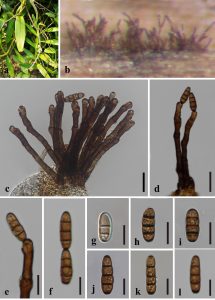Dendryphiella vinosa (Berk. & M.A. Curtis) Reisinger, Bulletin de la Société Mycologique de France 84: 27 (1968)
Index Fungorum number: IF329796
Saprobic on the stem of Dendrobium catenatum. Asexual morph: Colonies on natural substrate clustered, superficial, effuse, brown to dark brown. Conidiophores 70−106 μm long (x̅ = 86 μm, n = 25) macronematous, mononematous, erect, straight or slightly flexuous, unbranched, dark brown at base, slightly paler towards the apex, smooth or delicately rough-walled, septate, wider at septa. Conidiogenous cells polytretic, terminal and intercalary, integrated, proliferating asymmetrically, brown, enlarged at vertex. Conidia 17−29 × 5−8 μm (x̅ = 21.74 × 6.73 μm, n = 30), oblong with obtuse ends, rounded at apex, truncate at the base, forming simple or branched chains, pale brown when young, brown or dark brown, 3(4)-septate when mature, slightly constricted at septa, smooth or occasionally verruculose. Sexual morph: Undetermined.
Culture characteristics – Conidia germinated on PDA within 12 hours and germ tubes produced from both ends. Colonies reached about 5 cm diameter after 2 weeks on PDA at 26 °C. Mycelia are superficial, with entire edge, floccose at the center, white to light brown from above and light brown from below.
Material examined – China, Guangxi Province, Nanning City, on the stem of Dendrobium catenatum, 14 September 2019, Yaru Sun, G19 (MFLU 20-0444).
GenBank numbers – ITS: MT907477, LSU: MT907480.
Known distribution (based on molecular data) – Japan (Dela Cruz & Edison 2006) and China (this study).
Known hosts (based on molecular data) – decomposing leaf (Dela Cruz & Edison 2006) and Dendrobium catenatum (this study).
Notes – Dendryphiella vinosa was introduced by Reisinger (1968) on unidentified rotten leaves. Our collection only differs from the holotype in having shorter conidiophores (70−106 μm vs up to 400 μm). Detailed morphological study and molecular analysis of combined LSU and ITS sequence data indicated that our isolate clustered together with other D. vinosa strains. Comparisons of ITS sequences showed seven base pair differences without gaps between our collection and the holotype. We identified it as D. vinosa following the guidelines for species delineation proposed by Jeewon & Hyde (2016). This is the first geographical and host report of D. vinosa on Dendrobium catenatum in China.

